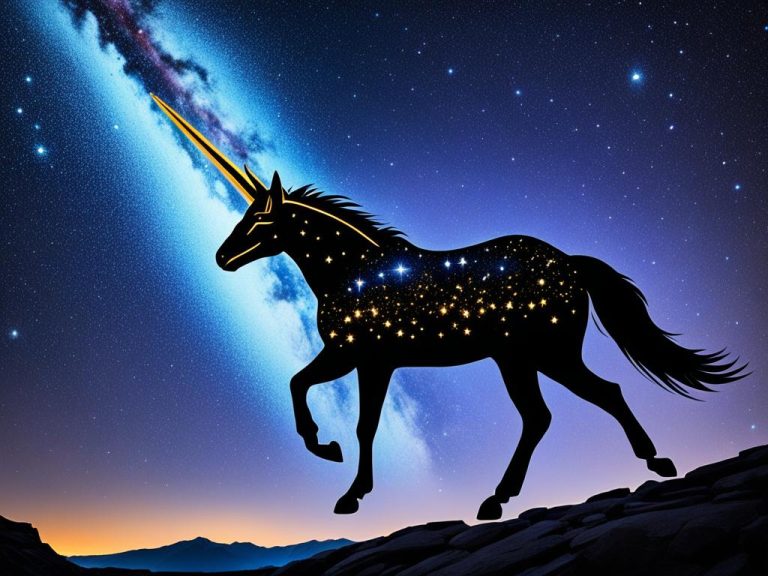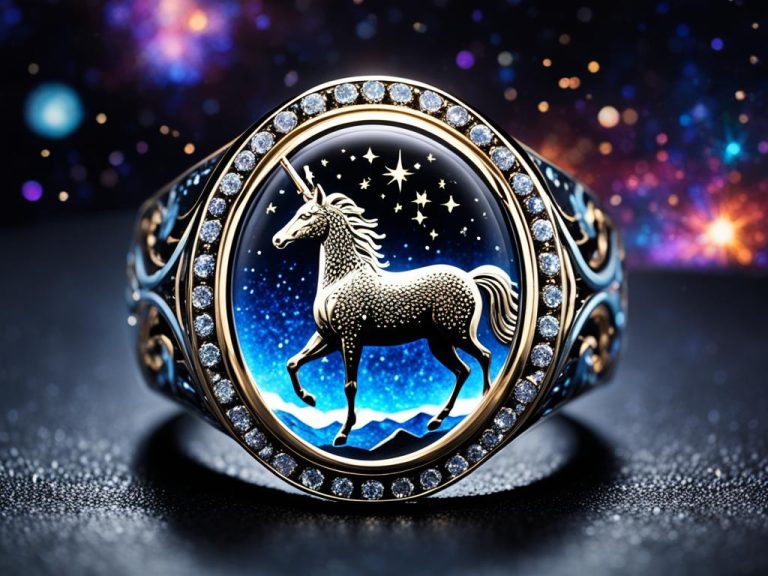Explore the Wonders of Monoceros Constellation
Did you know that Monoceros is the Unicorn constellation, a hidden gem in the night sky?
It’s found between Orion and Canis Major. Monoceros is not very clear but it has amazing sights. Winter nights reveal star clusters and nebulas for anyone who looks up.
One great thing about Monoceros is its star cluster. It makes the night sky shine more beautifully. Plus, there’s the story of the Celestial Unicorn, adding to Monoceros’s magic.
Love astronomy or just the universe’s beauty? A trip through Monoceros is filled with history, myths, and amazing sights. It’s a journey you won’t forget.

Key Takeaways:
- Monoceros constellation is a lesser-known but fascinating constellation between Orion and Canis Major.
- The Monoceros star cluster adds a touch of brilliance to the night sky.
- Monoceros Constellation holds significant mythological allure as the Celestial Unicorn.
- Exploring Monoceros offers an opportunity to delve into its rich history and astronomical marvels.
- Unlock the wonders of Monoceros Constellation and embark on a captivating celestial journey.
The Mythical Allure of Monoceros Constellation
Monoceros is a constellation you can see in the southern sky. It’s famous because people have linked it to unicorns. This connection has intrigued people for many years.
The unicorn, in Greek myth, was a magnificent horse with one horn. Monoceros isn’t exactly that, but it’s close to where myths about unicorns meet. So, people think of it as the unicorn constellation.
Monoceros is special because it’s full of stories of magic and charm. These tales come from many different cultures. They speak of purity, power, and the magical.
When you look at Monoceros in the night sky, feel its magic. Let it take you to a world where dreams are real, and the impossible can happen.
The Astronomical Significance of Monoceros Constellation
Monoceros is known for its beautiful sights in the sky. It features star clusters, nebulas, and galactic clusters. These make it both fascinating and important for astronomers.
Monoceros is home to many incredible stars. Stars like Beta Monocerotis, Gamma Monocerotis, and V838 Monocerotis shine brightly. They help us learn about how stars are born and change over time.
Also, Monoceros has stunning star-birth areas. The Rosette Nebula looks like a rose, and the Cone Nebula is cone-shaped. They show us how new stars and planets come to be, giving us clues about the cosmos.
The name “Monoceros” comes from a Latin word for “unicorn.” It was given by a Dutch mapmaker in the 1500s. This name adds an interesting touch to the constellation’s story.
Monoceros isn’t just pretty; it’s also a great place for science. It allows astronomers to learn about how stars and whole galaxies form. Studying Monoceros gives us more knowledge about the universe around us.
To understand the Monoceros constellation fully, we must look at it up close. Exploring this part of the sky can reveal many mysteries and wonders for us to enjoy.
International Star Registry and Naming a Star in Monoceros Constellation
Have you thought about a one-of-a-kind gift? Naming a star is special. International Star Registry lets you name a star in the Monoceros constellation. It’s perfect for birthdays, Christmas, or any special day.
Buying a star from here means your gift will stand out. They’ll get a certificate, star map, and coordinates. It shows your love, brings joy, and connects them to the universe.
Don’t wait to give a star as a gift. Visit their site and start your star-naming journey today. Make a gift of love that will last for many years.
Why Choose International Star Registry?
- Offers the opportunity to buy a star for someone
- Provides a unique and memorable gift
- Delivers a personalized star certificate, celestial coordinates, and a star map
This constellation is a favorite among celebrities. Some celebrities that have their very own stars named in Monoceros include Michelle Williams, Mariska Hargitay, Toni Braxton, and Heather Locklear.

Creating a Lasting Legacy Among the Stars
International Star Registry lets you create a timeless gift. Naming a star honors someone special. It shows your deep love and is unforgettable.
Buying a star is a great way to show your heart. Let International Star Registry help you on this amazing journey full of love and wonder.
Unveiling the Celestial Objects of Monoceros Constellation
Monoceros, the Unicorn constellation, is famous for its myths and the wonders in its skies. It houses two main features that catch the eye: the Rosette Nebula and the Christmas Tree Cluster.
Rosette Nebula:
The Rosette Nebula is like a grand cosmic cloud around an open star cluster. It shines with pink and red, drawing people in to look closer. You’ll need a telescope to see it well, but its beauty is worth the effort.
Christmas Tree Cluster:
The Christmas Tree Cluster looks like a tree with bright ornaments against the dark. It contains young stars and the Cone Nebula, making it look festive and magical. You can see it with small telescopes or even binoculars.
Monoceros offers more than just the Rosette Nebula and Christmas Tree Cluster. It gives us a chance to see the vast and diverse universe we live in. The wonders there remind us how beautiful our universe really is and why we continue to explore it.
The Role of Amateur Astronomers in Observing Monoceros Constellation
Amateur astronomers and stargazers help solve the Monoceros constellation’s secrets. They use backyard telescopes to share important data with scientists. Their love for the night sky drives them to discover its mysteries.
With special cameras, they take stunning photos of Monoceros’ sights. These images teach us about nebulae and variable stars. By watching for changes, they increase our knowledge of Monoceros’ lively nature.
Telescopes at home give them a different view of space. It lets them explore the universe’s beauty while at home. Their passion and curiosity lead to big steps in astronomy.
They also connect through apps and online groups to share what they learn. This teamwork creates a strong community. It helps newcomers start their own journey into space.
Amateur astronomers show us the universe is for everyone, not just scientists. Their hard work motivates us to look up and wonder about our place in space. Together, they and professionals study Monoceros to find its hidden wonders.
Professional Discoveries in Monoceros Constellation
Professional astronomers found amazing things in the Monoceros constellation. They uncovered the Monoceros Ring, a path of stars around the Milky Way. This discovery helps us learn more about how galaxies start and grow, making the universe clearer for all of us [source].
In Monoceros, there’s the Rosette Nebula (NGC 2244). This area is like a nursery for stars, showing off with gas and dust clouds where stars are born. It’s known for its stunning looks and is a favorite for astronomers and fans of space photography [source].
Also, Monoceros is home to big, old stars called red supergiants. These stars are at the last part of their lives and help scientists understand how stars change over time. By looking at a star’s light in detail, called spectroscopy, they figure out how these giant stars work [source].

The European Southern Observatory (ESO) and its VISTA telescope are a big part of these amazing discoveries in Monoceros. VISTA is the biggest infrared camera on a telescope and has been scanning the sky since 2010. It brings in tons of data every night, helping scientists learn more about Monoceros [source].
The ESO works in Chile at places like Cerro Paranal. It’s a leader in astronomy research, supported by 14 countries. Thanks to the ESO, we keep learning new and exciting things about the Monoceros star cluster [source].
Since the 17th century, when Monoceros was first drawn, to the new facts about planets and stars, astronomers have amazed us. Their hard work opens our eyes to the wonders of Monoceros, teaching us about the vast and beautiful universe. It’s a team effort that brings the mysteries of the Monoceros sky closer for us all to wonder at.
Unveiling the History and Mythology of Monoceros Constellation
The Monoceros constellation has captured the hearts of people for a long time. Astronomers and stargazers have been fascinated by it since the early 17th century. This was thanks to Petrus Plancius. It is a standout feature in our night sky.
Monoceros is linked with the unicorn of myths, found in many ancient cultures. Its name comes from the Greek word for “unicorn.” This makes Monoceros very magical and interesting.
Even though Monoceros isn’t the brightest, its story and meaning are special. It stands out next to Orion, Eridanus, and a few others. Together, they make a beautiful picture in the sky.
The unicorn represented purity and grace in ancient tales. It was said to bring magic, innocence, and healing.
Monoceros shines in the night sky, reminding us of these ancient stories. It makes us look up with wonder, like our ancestors did long ago.
Monoceros is not the most famous constellation. But, its tales can teach us a lot about culture and history. The stories of Monoceros can show how the night sky has touched human hearts over the years.
Looking deeper into Monoceros, one finds many celestial wonders. Stars, nebulae, and other mysteries are there. They keep astronomers and dreamers curious and amazed.
For detailed info on Monoceros, visit here. Learn more about Orion’s tales on Star Walk.
Discovering Monoceros brings us closer to the ancient marvels of the night. It shows how stories, legends, and science mix in the sky. This is what makes us look up and wonder.
The Beauty and Wonder of Monoceros Constellation
Monoceros is loved by people who watch the stars. It shows a unicorn in the night sky. This unicorn shape is faint but beautiful, thanks to its stars and dust clouds.
Looking up, you can see a Celestial Unicorn, or Monoceros. It’s placed near Canis Major and Orion. Its bright stars and mysterious look catch everyone’s eyes.
The word Monoceros means “unicorn” in Greek. This name fits its magical image perfectly. People have found it interesting for a long time, including scientists and those who love myths.
In the center of Monoceros, there is a lot to see. You find clusters, nebulae, and beautiful stars. Alpha Monocerotis and Beta Monocerotis are among these stars. They light up the sky in different colors.
The Rosette Nebula is a special part of Monoceros. It’s where stars are born. This area shines with a soft, lovely color, making it a delight to see.
Many sky gazers enjoy exploring Monoceros. They use simple telescopes and a love for space. This way, they discover the universe’s hidden stories, like star clusters and more.
Researchers also look closely at Monoceros. Their big telescopes reveal deep mysteries. They learn more about how stars and planets form.
Thinking about a memorable gift? International Star Registry has a great idea. You can name a star in Monoceros and give it to someone special. They’ll have a unique star to remember forever.
Monoceros goes beyond just being a constellation. It leads us on an amazing journey. Looking at it makes us feel the universe’s grandness. It shows us how we fit into a larger world.
So, look up at Monoceros in the night sky. Let its beauty and secrets enchant you. It’s a special sight that anyone can enjoy.
Conclusion
The Monoceros constellation is full of stories, myths, and stars for you to enjoy. It covers 482 square degrees and is full of interesting things for both beginners and experts. Monoceros shows us just how vast and pretty space is.
When you look at Monoceros, the Red Rectangle Nebula might catch your eye. It is thought to look like an X because of spinning jets from its center. Then there’s the Rosette Nebula, lit up by R Monocerotis, which is both a pretty cloud and an X-ray source. And M50, also called Messier Object 50, is a lovely open cluster in Monoceros.
If you love looking at stars or are just curious, Monoceros is a great place to learn more. It helps you see the secrets of the sky and makes you love the universe more.
Don’t forget Monoceros on your next star-gazing adventure. Let this beautiful constellation show you the way to more cosmic wonders.
FAQ
What is Monoceros Constellation?
Monoceros is the Unicorn constellation. It’s faint and found in winter. It sits between Orion and his two dogs.
What is the association between Monoceros and the unicorn?
Monoceros is linked to the unicorn through myths. Even though it doesn’t look like a unicorn, it’s near other constellations linked to unicorn tales.
What celestial objects can be found in Monoceros?
In Monoceros, you’ll find star clusters, nebulas, and galactic clusters. Notable ones include Beta Monocerotis, the Rosette Nebula, and the Christmas Tree Cluster.
Can I name a star in the Monoceros Constellation?
Yes, you can name a star in Monoceros. International Star Registry lets you do this. It’s a special gift for any occasion.
What are the celestial objects that can be observed in Monoceros?
Monoceros has spectacular sights like the Rosette Nebula. It surrounds an open cluster. Also, the Christmas Tree Cluster looks like an evergreen tree.
What is the history and mythology behind the Monoceros Constellation?
Petrus Plancius may have listed Monoceros first in the early 17th century. It is tied to the unicorn through stories from around the world.
Source Links
- The Monoceros Constellation (The Mythical Unicorn of Stars) – https://spaceknowledge9.rssing.com/chan-80877855/article7.html
- Monoceros | Nature Friend Magazine – https://naturefriendmagazine.com/monoceros/
